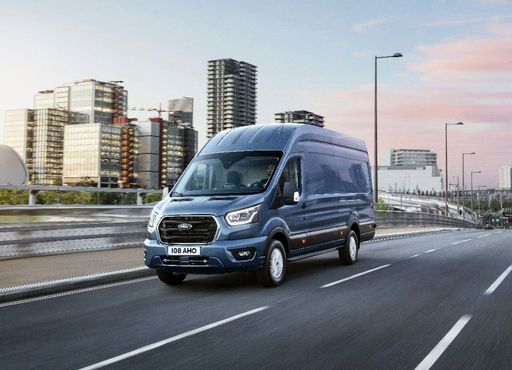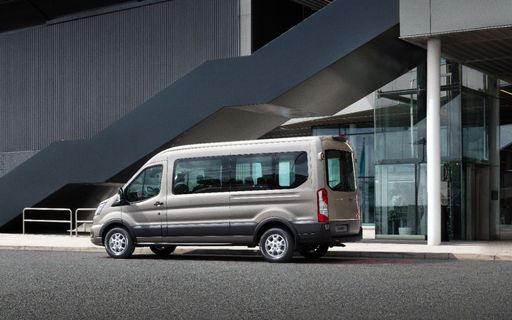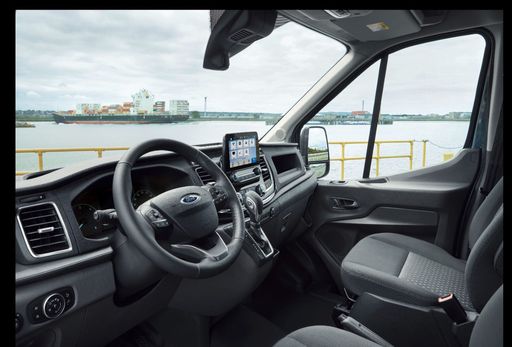Ford Transit Courier VS Renault Trafic Bus – Specs, Efficiency & Price Comparison
Which model is the better choice – the Ford Transit Courier or the Renault Trafic Bus? We compare performance (136 HP vs 150 HP), boot capacity ( vs ), efficiency ( vs 6.80 L), and of course, the price (18900 £ vs 38200 £).
Find out now which car fits your needs better!
The Ford Transit Courier (Cargo Van) is powered by a Petrol, Diesel or Electric engine and comes with a Manuel or Automatic transmission. In comparison, the Renault Trafic Bus (Bus) features a Diesel engine and a Manuel gearbox.
When it comes to boot capacity, the Ford Transit Courier offers , while the Renault Trafic Bus provides – depending on what matters most to you. If you’re looking for more power, you’ll need to decide whether the 136 HP of the Ford Transit Courier or the 150 HP of the Renault Trafic Bus suits your needs better.
There are also differences in efficiency: vs 6.80 L. In terms of price, the Ford Transit Courier starts at 18900 £, while the Renault Trafic Bus is available from 38200 £.
Compare all the key specs now and find out which model fits your lifestyle best!
Ford Transit Courier
The Ford Transit Courier is a compact and versatile van that offers practicality and efficiency for urban driving. With its spacious interior and smart storage solutions, it caters well to the needs of small businesses and delivery drivers. The vehicle's design combines functionality with a modern aesthetic, making it a popular choice in the light commercial vehicle market.
details @ media.ford.com
@ media.ford.com
 @ media.ford.com
@ media.ford.com
 @ media.ford.com
@ media.ford.com
Renault Trafic Bus
The Renault Trafic Bus is a versatile and spacious option for those needing to transport multiple passengers comfortably. With its modern design and practical features, it is well-suited for both business and leisure purposes. Its efficient engine and smooth handling make it a reliable choice for long journeys.
details

|
|
|
|
|
Costs and Consumption |
|
|---|---|
|
Price
18900 - 31100 £
|
Price
38200 - 51100 £
|
|
Consumption L/100km
-
|
Consumption L/100km
6.8 - 7.2 L
|
|
Consumption kWh/100km
-
|
Consumption kWh/100km
-
|
|
Electric Range
293 km
|
Electric Range
-
|
|
Battery Capacity
43.50 kWh
|
Battery Capacity
-
|
|
co2
0 g/km
|
co2
179 - 188 g/km
|
|
Fuel tank capacity
44 - 45 L
|
Fuel tank capacity
80 L
|
Dimensions and Body |
|
|---|---|
|
Body Type
Cargo Van
|
Body Type
Bus
|
|
Seats
2 - 5
|
Seats
8 - 9
|
|
Doors
3 - 5
|
Doors
4
|
|
Curb weight
-
|
Curb weight
2031 - 2321 kg
|
|
Trunk capacity
-
|
Trunk capacity
-
|
|
Length
4337 - 4344 mm
|
Length
5080 - 5480 mm
|
|
Width
1800 - 1813 mm
|
Width
1956 mm
|
|
Height
1819 - 1839 mm
|
Height
1973 - 1974 mm
|
|
Payload
-
|
Payload
749 - 982 kg
|
Engine and Performance |
|
|---|---|
|
Engine Type
Petrol, Diesel, Electric
|
Engine Type
Diesel
|
|
Transmission
Manuel, Automatic
|
Transmission
Manuel
|
|
Transmission Detail
Schaltgetriebe, Automatikgetriebe
|
Transmission Detail
Schaltgetriebe
|
|
Drive Type
Front-Wheel Drive
|
Drive Type
Front-Wheel Drive
|
|
Power HP
100 - 136 HP
|
Power HP
110 - 150 HP
|
|
Acceleration 0-100km/h
-
|
Acceleration 0-100km/h
13.6 - 16.5 s
|
|
Max Speed
-
|
Max Speed
161 - 174 km/h
|
|
Torque
170 - 290 Nm
|
Torque
300 - 350 Nm
|
|
Number of Cylinders
3 - 4
|
Number of Cylinders
4
|
|
Power kW
74 - 100 kW
|
Power kW
81 - 110 kW
|
|
Engine capacity
998 - 1500 cm3
|
Engine capacity
1997 cm3
|
General |
|
|---|---|
|
Model Year
2023 - 2025
|
Model Year
2023 - 2024
|
|
CO2 Efficiency Class
A
|
CO2 Efficiency Class
G
|
|
Brand
Ford
|
Brand
Renault
|
Ford Transit Courier
The All-New Ford Transit Courier: Small Package, Big Performance
The Ford Transit Courier has long been a reliable companion for businesses seeking practicality, versatility, and economy without sacrificing performance. As part of the new 2023 model range, the Transit Courier continues to deliver with updated features and enhanced capabilities. But what makes this small but mighty van stand out in its segment? Let's dive deeper into its technical details and innovations.
Engine and Performance: Power Meets Efficiency
Under the bonnet, the Ford Transit Courier offers a selection of efficient engines designed to maximise performance while keeping running costs low. The range comprises both petrol and diesel variants, with power outputs ranging from 100 PS to a robust 125 PS. The 1.0 EcoBoost engines are well-known for their blend of power and fuel efficiency, making them ideal for urban deliveries and longer hauls alike. Meanwhile, the 1.5 EcoBlue diesel engines provide a torque-rich drive, offering reliable power for those who demand more from their vehicle.
Transmission Options: Tailored for Every Driver
The Ford Transit Courier caters to diverse driving preferences with both manual and automatic transmission options. The manual gearbox provides drivers with a hands-on, engaging drive, while the automatic transmission offers seamless gear changes for a more relaxed experience, perfect for navigating busy city streets or highways.
Sleek Design Meets Functionality: Dimensions and Capacity
Despite its compact size, the Ford Transit Courier maximises interior space with its intelligent design. Measuring between 4337 mm and 4344 mm in length and up to 1813 mm in width, its spacious cargo area is complemented by a well-thought-out cabin, ensuring driver comfort and ample storage solutions. With a height between 1827 mm and 1839 mm, the Transit Courier provides ease of access and loading convenience.
Advanced Technology: The Future of Driving
The 2023 model year brings cutting-edge technology features to the fore. From advanced driver-assist features to enhance safety, such as lane-keeping assist and adaptive cruise control, to intuitive infotainment systems designed to keep drivers connected on the move, the Ford Transit Courier ensures a modern driving experience reflective of its innovative spirit.
Practicality Over Everything: A Vivid Example
True to its reputation, the Transit Courier continues to prioritise practicality. With seating for two, a configurable cargo area, and various trim levels including Active, Basis, Limited, and Trend, businesses can select a model that best suits their needs and budget. Prices range from €22,075 to €29,453, ensuring a versatile choice for any business requirement.
Efficient and Ready: The Final Verdict
The Ford Transit Courier is more than just a compact van; it is a reliable workhorse designed to meet the challenges of modern business. Its combination of fuel-efficient engines, practical design, and innovative technology ensures it remains a top contender in its class. Whether you're a small business owner or a fleet manager, the Transit Courier is an investment in efficiency and reliability.
Renault Trafic Bus
A Glimpse into the Renault Trafic Bus: An Icon of Versatility and Innovation
Amongst the plethora of vans designed for both business and leisure, the Renault Trafic Bus stands out as an exemplar of functionality, innovation, and style. Let's delve into what makes the Renault Trafic Bus a popular choice in the UK and across Europe, particularly focusing on its technical specifications and state-of-the-art features.
Performance Dynamics: Power Under the Hood
The Renault Trafic Bus, a staple in Renault's fleet, is driven by a robust diesel engine configuration with power outputs ranging from 110 PS to a formidable 170 PS. The diesel engines combine efficiency and power, offering torque figures between 300 to 380 Nm, ensuring smooth power delivery and capable load hauling.
Drivers can choose between manual and automatic transmissions, both designed to complement the Trafic's front-wheel-drive system. This flexibility ensures that drivers experience enhanced driving comfort whether they are navigating urban roads or cruising on the motorway.
Efficiency Meets Economy
The Trafic Bus showcases impressive fuel economy with consumption figures ranging from 6.8 to 7.2 litres per 100 kilometres. This efficiency is crucial for businesses aiming to minimise operational costs and for families seeking budget-friendly travel options.
With a generous fuel tank capacity of 80 litres, the Renault Trafic Bus is built to cover long distances with fewer fuel stops, making it an ideal choice for long haul journeys.
Technological Innovations and Comfort
The Trafic Bus isn't just about robust performance. Renault has integrated a suite of technological innovations designed to enhance driver and passenger comfort. Its cabins are equipped with the latest infotainment systems and safety technologies, providing an optimal blend of comfort and convenience.
The various trims, such as Life, Start, Spaceclass, and their respective EDC variants, cater to different needs and preferences, ensuring that customers can find the perfect configuration for their requirements.
Design and Dimensions: Space for Every Purpose
Space and versatility are at the heart of the Trafic Bus design. With its dimensions ranging from a length of 5080 to 5480 mm, and a width of 1956 mm, this vehicle offers ample room for passengers and cargo alike. The height stands between 1973 and 1974 mm, ensuring that even taller individuals can travel comfortably.
With seating for up to eight people and a payload capacity between 730 to 1010 kg, the Trafic Bus can transform seamlessly between a people-mover and a goods carrier.
Environmental Considerations
Renault has engineered the Trafic Bus with environmental responsibility in mind. The CO2 emissions range from 178 to 190 g/km, which, while modest for its class, aligns with the efficiency and performance goals set for this versatile vehicle. The CO2 efficiency class is rated as 'G', offering transparency in its environmental impact profile.
Conclusion: A Leader in Its Class
The Renault Trafic Bus continues to lead its segment through a blend of power, efficiency, and technological advancements. Whether it's for commercial transport or family adventures, the Trafic offers a reliable and adaptable solution, setting a high standard for multi-purpose vehicles.
For those seeking a distinguished blend of utility and comfort, the Renault Trafic Bus emerges as an exceptional choice, promising performance and innovation on every journey.
The prices and data displayed are estimates based on German list prices and may vary by country. This information is not legally binding.
